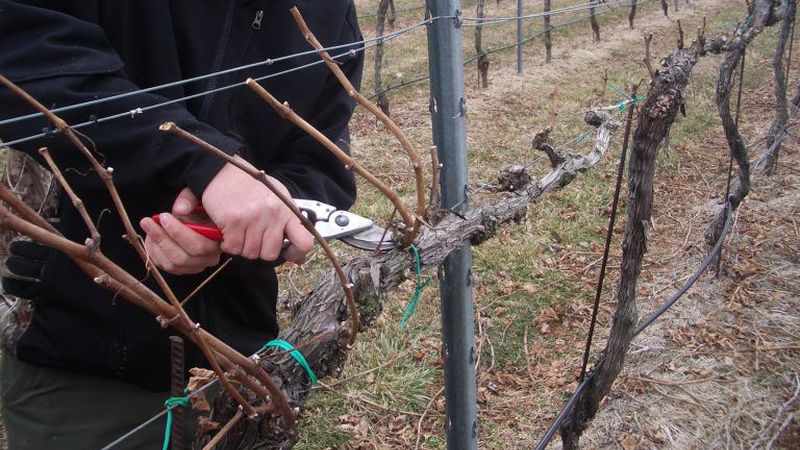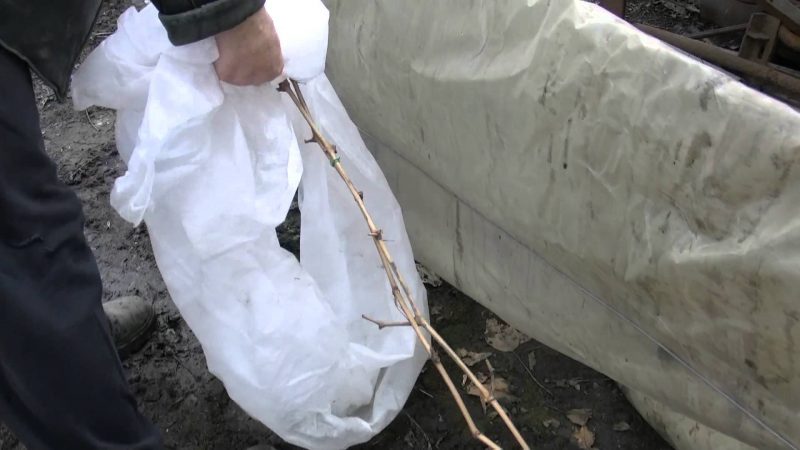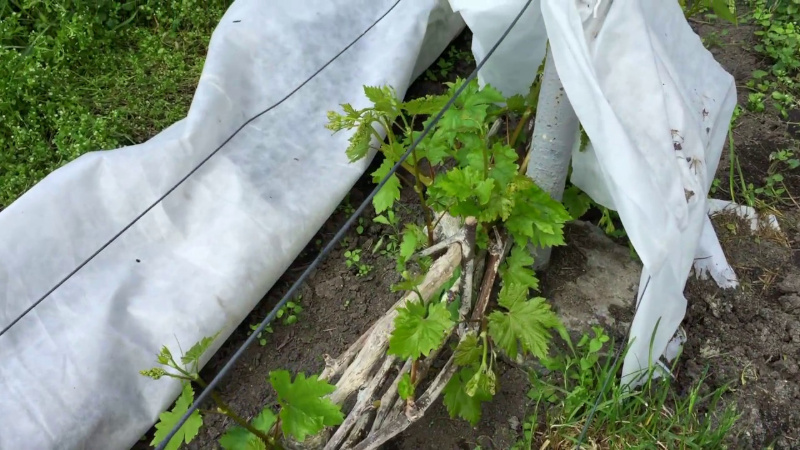Features of warming grapes in Siberia: how to properly cover for the winter
Many gardeners in Siberia are passionate about growing grapes, but the climatic features of the region make their own adjustments to this process. Breeders develop new frost-resistant varieties every year. However, grapes still need care and shelter for the winter. How to properly and how to cover it will be discussed in this article.
The content of the article
Features of the climate of Siberia
In Western Siberia, the climate is sharply continental, and the peculiarity of the relief affects the weather conditions of the eastern part of Siberia. Winters in the macroregion are long and frosty, and summers are short. But such conditions also have advantages for gardening. The grapes are resistant to pests, not susceptible to diseases. In Siberia, it is not affected by the dangerous phylloxera aphid.
Despite the peculiarities of the climate, early and some mid-season varieties grow successfully and yield a harvest, provided that the vine is covered, protecting it from freezing.

Shelter terms for grape bushes in Siberia
Siberian autumn takes a short period of time, no more than two months, and quickly turns into a harsh long winter. For this reason, the grapes begin to cover in late September - early October, in order to catch up with the first frost. But there is no need to rush.
The vine can be removed from the trellises earlier, but it is better to wait until the leaves fall off, not to pick them off yourself. At this time, complex biochemical processes take place in the vine for the complete maturation of shoots and buds.
At what temperature to cover grapes
It is not necessary to wrap the entire bush at once. Changes in temperature can cause condensation and plant drying out. A period is needed when the fluctuations in near-minus temperatures pass - before the snow falls. It is useful to harden the plant at -5 ... -8 ° C. You can finally cover the grapes at a constant temperature below -10 ° C.
Reference. In Siberia, the grape shelter is completed by mid-October.
Which grapes do not need to be covered and why
Technical and some table varieties tolerate winter well. Non-sheltering ones also include frost-resistant ones: Isabella, Lydia, Amethyst.
Juices and wines are made from Isabella grapes. The varieties Lydia and Amethyst are most often used to decorate gazebos.
How to prepare grapes for shelter in Siberia
Preparation of the bush for winter begins in September immediately after the harvest. It includes pruning, watering, top dressing... The growth of the vine and the harvest of the next year depend on how the plant overwinters.
Pruning

Pruning makes it easier to cover the vines. The best time for the procedure is mid-September, but at least 1-2 weeks after harvest, so that the plant has time to recover. If by that time the bush has not thrown off the leaves, they are shaken off by hand. If you cut it before the leaves fall, the vine will lose its plasticity. Such branches will break when laid in a trench.
Cut the vine to living wood - its cut should be light green. Above a living bud, leave 1-2 cm of the shoot. After pruning, a certain number of buds should remain on each fruit branch, depending on the thickness of the shoot:
- 5 mm - 5 pcs.;
- 6 mm - 5-6 pcs.;
- 7 mm - 7-8 pcs.;
- 8 mm - 8-9 pcs.;
- 9 mm - 9-11 pcs.;
- 10 mm - 11-13 pcs.;
- 11 mm - 12-14 pcs.;
- 12 mm - 13-15 pcs.
On the plant, 30% of spare eyes are left in case of freezing.
Important! Fruiting shoots are shortened by 60-90%.
Watering
The frequency and abundance of moisture depends on the composition of the soil. The sandy substrate requires frequent but moderate watering. Clay soil is rarely and abundantly watered. After harvesting, watering can be stopped for a while. This imitation of drought will accelerate the ripening and lignification of the vine, and the grapes will winter better.
Moisture-charging irrigation is carried out at the end of September, on the last sunny days. After it, the lashes will be saturated with moisture, become flexible, and it will be easy to bend them to the ground. For fruiting plants, the norm is 100-150 liters per 1 sq. m landings.
Top dressing
During the growing season, the plant consumes its entire supply of nutrients. To lay the buds of the future harvest, you need to fertilize it:
- Spill the soil with a solution of phosphorus and potassium fertilizers (20 g and 10 g per 10 liters of water).
- Once every three years, the following composition is applied under the bush: 1 kg of black soil, 30 g of superphosphate, 30 g of potash fertilizer.
- Boric acid, potassium permanganate, iodine and zinc sulfate can be added to the water for irrigation, but not more than 15 g of each substance per 10 liters of water.
Before winter, grapes should not be fed with nitrogen-containing mineral compounds, which cause a rapid growth of green mass.
Treatment against diseases and pests
The spores of fungi on the bark and foliage survive at sub-zero temperatures. To prevent their re-spread, it is necessary to carry out preventive spraying with 1% copper sulfate. In the fight against powdery mildew and mites, the preparations "Nitrofen" and "DNOC" are suitable.
Disinfection of covering material

The nonwoven does not need to be decontaminated. But natural is better process:
- Dry foliage. It is raked around the trunk and treated with fungicides ("Maxim," Oxyhom, "Fundazol") or Bordeaux liquid from the spores of pathogenic fungi.
- Straw. Herbs are added to it, which scare away rodents. These are wormwood, marigolds, tansy.
- Spruce branches itself has disinfecting properties.
- Wooden flooring, mats, straw mats are treated with a solution of copper sulfate in a proportion of 10 g per 1 liter of water.
Shelter methods
How to shelter grapes for the winter in Siberia? There are many types of hiding places. Each gardener decides for himself which way to use it. For shelter, slate, cardboard, natural materials, snow are used.
The influence of climate on the choice of method
In regions with a changeable climate, where winter is accompanied by thaws and rains, air-dry shelters are made for grapes. The tunnel method provides guaranteed protection against freezing, soaking and icing. In regions where there is little snow, you will not be able to use a cover made of snow and earth.
Stamp dripping
This type of shelter is used in relation to young plants. A vine older than a year cannot be covered in this way. The branches of the vine are fastened together and bent down. The stem is buried in a layer of earth 20-25 cm high.
Semi-shelter
This method is used for frost-resistant varieties in the harsh conditions of Siberia.
Procedure:
- Remove the vine from the support.
- Lay on the ground.
- Cover with agrofiber.
Full cover
It is used for young plants and regions where the temperature drops to -20 ° C in winter. Ground and snow are used for protection.
Snow
Snow acts as a natural insulation that protects the bushes from freezing. The vine is bent to the ground, the hole is covered with earth, and later covered with snow. Every centimeter of snow provides one degree of warmth to the plant.
The ground
The oldest and most reliable method. A trench is dug along the row on a shovel bayonet, tied vines are laid and sprinkled with an earthen mound 15-20 cm high.
There is a drawback to this method: the plant can be resistant, since no vents are provided.
Straw or reed
This method refers to trenching. They dig a trench along the plantings, lay the vines tied in a bundle, and cover them with straw or reed on top.
The method is not very suitable for winter shelter in Siberia, as it can attract mice.
Foliage
The foliage is collected around the bush and poured on top of the vine 30-35 cm thick, thereby protecting the roots from freezing. But first it must be treated with fungicides, for example, "Fundazol", "Oxyhom" or Bordeaux liquid. A film is stretched over the layer of leaves.
Needles
This is not the best insulation. The needles get wet, freeze up, preventing the vine from breathing, and provides weak insulation.
Other materials

Instead of coniferous litter, it is better to use spruce branches. Coniferous branches allow air to pass through well, disinfect and scare away rodents.
Sawdust is also used, but they must be covered with foil. This is not a very good option, since the material attracts mice.
Important! Calcium carbide is placed under winter shelters, which scares away rodents.
Dry shelter
The safest and most common way. The vine is also bent to the ground, but it is laid on a non-woven material or any dry organic matter. This keeps the vine out of contact with the ground and remains dry. Insulation is pulled from above, leaving an air gap between the plant and the shelter.
Slate
The slate prevents rainfall from entering the vineyard. A film or agrofibre is laid under the vine, and spruce branches are insulated on top. The entire structure is covered with slate.
Film
The material is stretched over metal arcs. It turns out a low greenhouse. Cardboard or planks covered with spruce branches or straw are laid under the vine.

Roofing material
Roofing material is used in the same way as a film, or combined with wooden boards. Wooden shields are installed over the laid grapes, and they are covered with roofing material on top. The structure resembles a gable roof of a house. Fasten with sprinkled earth.
Boxes
Boxes are used in the same way as roofing material, or they are attached to metal arcs, like a film.
Other materials
Styrofoam can be used. The bush is insulated with coniferous needles, covered with pieces of foam and wrapped in polyethylene. In the spring, the foam is removed, and the needles are left as mulch.
You can wrap mature plants with several layers of agrofibre and secure with twine. A layer of snow is well retained on its surface.
Which method is preferable in Siberia
In Siberia, preference is given to the dry method of shelter using available materials. Dig a trench or set up greenhouses. Great attention when preparing they are given to the root system for winter. The trunk circle is covered with spruce branches.
Features of the shelter of young grapes

Young plants are very sensitive to cold and therefore need to be protected as much as possible. They spud a young bush and put a frame made of metal or wood (bucket, wooden box) on it. Cover with foil and roofing felt from above.
Common mistakes
Violation of the timing and technology of preparation for winter can destroy the grapes:
- Early shelter... The vine needs to be given time to harden, so it will survive the winter better. First, they make a temporary shelter, and when a stable temperature is established below -10 ° C, you can wrap up the bushes.
- Contact with the ground. In Siberia, it is better to use the dry method, when a layer of spruce branches, leaves or non-woven material is underlain under the laid vine. This way the vines are more likely to fail.
- Hasty release from protection in spring. Take your time to get rid of the covering material. Recurrent frosts are dangerous for young buds. Release the grapes when the snow has completely melted and the temperature is above zero.
Conclusion
In order for the grapes to overwinter, they need to be prepared - in a timely manner, cut, feed and water, allow the vine to ripen and harden.It is important to take care of the shelter, since in Siberia, snow is not enough to protect against frost and temperature changes. Well wintered grapes will definitely please with the harvest next year.